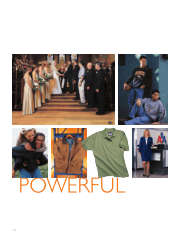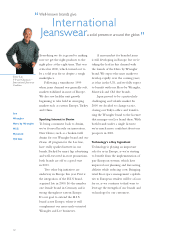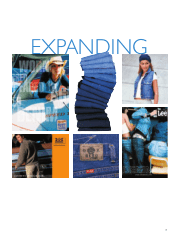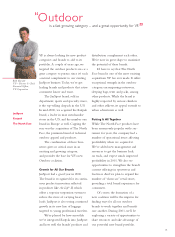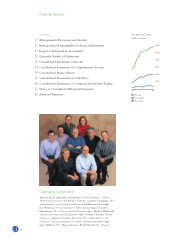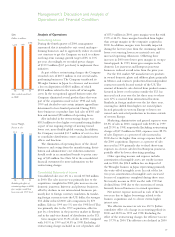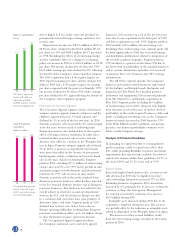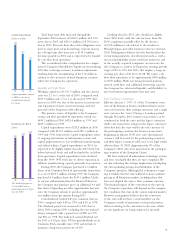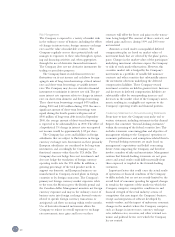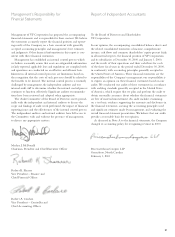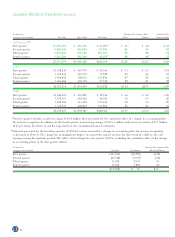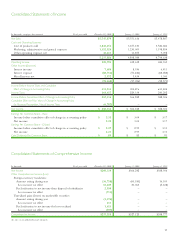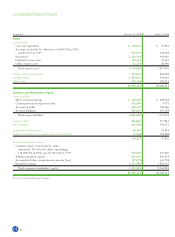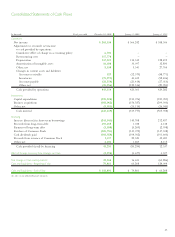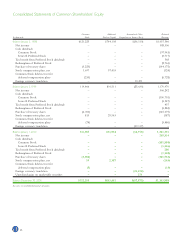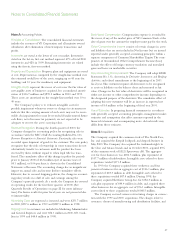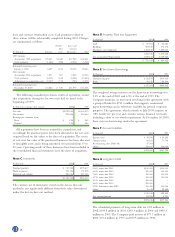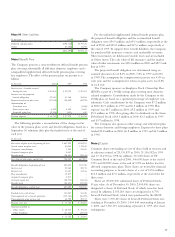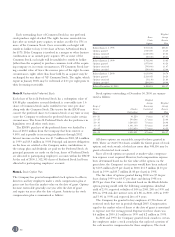North Face 2000 Annual Report Download - page 22
Download and view the complete annual report
Please find page 22 of the 2000 North Face annual report below. You can navigate through the pages in the report by either clicking on the pages listed below, or by using the keyword search tool below to find specific information within the annual report.
20
Risk Management
The Company is exposed to a variety of market risks
in the ordinary course of business, including the effects
of changes in interest rates, foreign currency exchange
rates and the value of marketable securities. The
Company regularly assesses these potential risks and
manages its exposures to these risks through its operat-
ing and financing activities and, when appropriate,
through the use of derivative financial instruments.
The Company does not use derivative instruments for
trading or speculative purposes.
The Company limits its risk from interest rate
fluctuations on its net income and cash flows by man-
aging its mix of long-term borrowings at fixed interest
rates and short-term borrowings at variable interest
rates. The Company may also use derivative financial
instruments to minimize its interest rate risk. The pri-
mary interest rate exposure relates to changes in interest
rates on short-term domestic and foreign borrowings.
These short-term borrowings averaged $470 million
during 2000 and $430 million during 1999. Because a
significant amount of short-term borrowings were
repaid during the fourth quarter with proceeds of
$500 million of long-term debt issued in September
2000, the average amount of short-term borrowings
is expected to be substantially less in 2001. The effect of
a hypothetical 1% change in interest rates on reported
net income would be approximately $.02 per share.
The Company has assets and liabilities in foreign
subsidiaries that are subject to fluctuations in foreign
currency exchange rates. Investments in these primarily
European subsidiaries are considered to be long-term
investments, and accordingly, the Company uses a
functional currency other than the U.S. dollar. The
Company does not hedge these net investments and
does not hedge the translation of foreign currency
operating results into the U.S. dollar. In addition, a
growing percentage of the total product needs to
support our domestic and European businesses are
manufactured in Company-owned plants in foreign
countries or by foreign contractors. The Company’s
primary net foreign currency market exposures relate
to the euro, the Mexican peso, the British pound and
the Canadian dollar. Management monitors net foreign
currency exposures and may in the ordinary course of
business enter into foreign exchange forward contracts
related to specific foreign currency transactions or
anticipated cash flows occurring within twelve months.
Use of derivative financial instruments allows the
Company to reduce its overall exposure to exchange
rate movements, since gains and losses on these
contracts will offset the losses and gains on the transac-
tions being hedged. The amount of these contracts, and
related gains and losses, during 1999 and 2000 were
not material.
Amounts accrued under a nonqualified deferred
compensation plan are based on market values of
investment funds that are selected by the plans’ partici-
pants. Changes in the market values of the participants’
underlying investment selections expose the Company
to risks of stock market fluctuations. However, this
securities market risk is hedged by the Company’s
investments in a portfolio of variable life insurance
contracts and other securities that substantially mirror
the investment selections underlying the deferred
compensation liabilities. These Company-owned
investment securities are held in grantor trusts. Increases
and decreases in deferred compensation liabilities are
substantially offset by corresponding increases and
decreases in the market value of the Company’s invest-
ments, resulting in a negligible net exposure to the
Company’s operating results and financial position.
Cautionary Statement on Forward-Looking Statements
From time to time, the Company may make oral or
written statements, including statements in this Annual
Report, that constitute “forward-looking statements”
within the meaning of the federal securities laws. This
includes statements concerning plans and objectives of
management relating to the Company’s operations or
economic performance, and assumptions related thereto.
Forward-looking statements are made based on
management’s expectations and beliefs concerning
future events impacting the Company and therefore
involve a number of risks and uncertainties. Management
cautions that forward-looking statements are not guar-
antees and actual results could differ materially from
those expressed or implied in the forward-looking
statements.
Important factors that could cause the actual results
of operations or financial condition of the Company
to differ include, but are not necessarily limited to, the
overall level of consumer spending for apparel; changes
in trends in the segments of the market in which the
Company competes; competitive conditions in and
financial strength of the retail industry; actions of
competitors that may impact the Company’s business;
receipt and integration of software developed by
outside vendors; and the impact of unforeseen economic
changes in the markets where the Company competes,
such as changes in interest rates, currency exchange
rates, inflation rates, recession, and other external eco-
nomic and political factors over which the Company
has no control.


